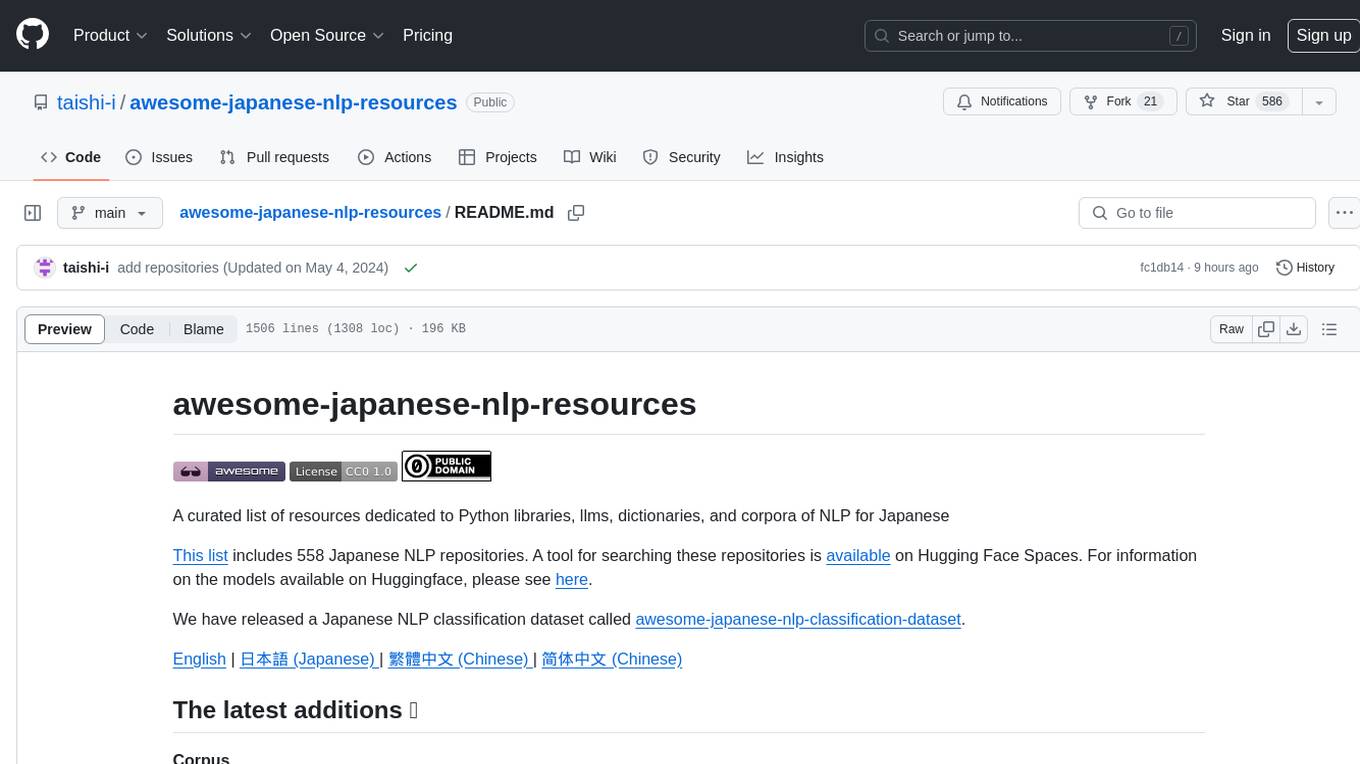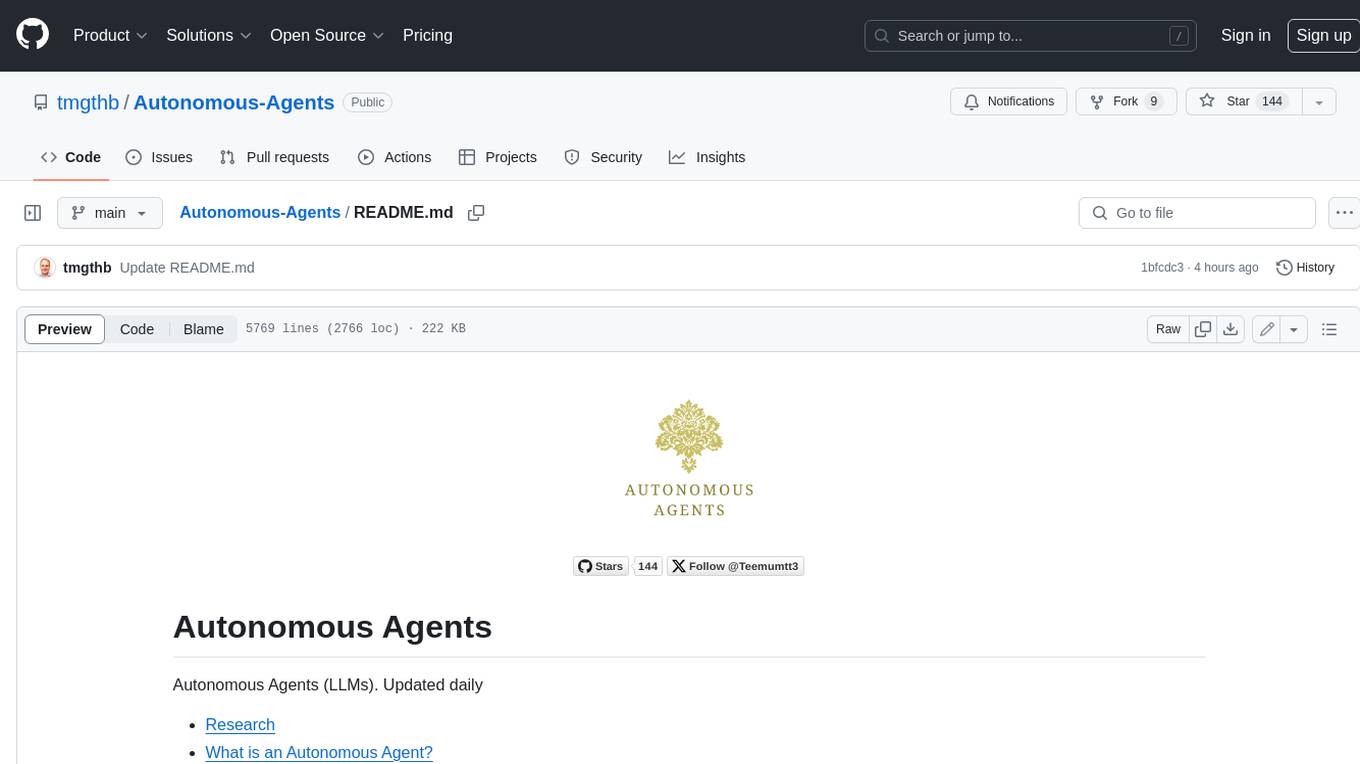
cosmos-predict1
Cosmos-Predict1 is a collection of general-purpose world foundation models for Physical AI that can be fine-tuned into customized world models for downstream applications.
Stars: 115
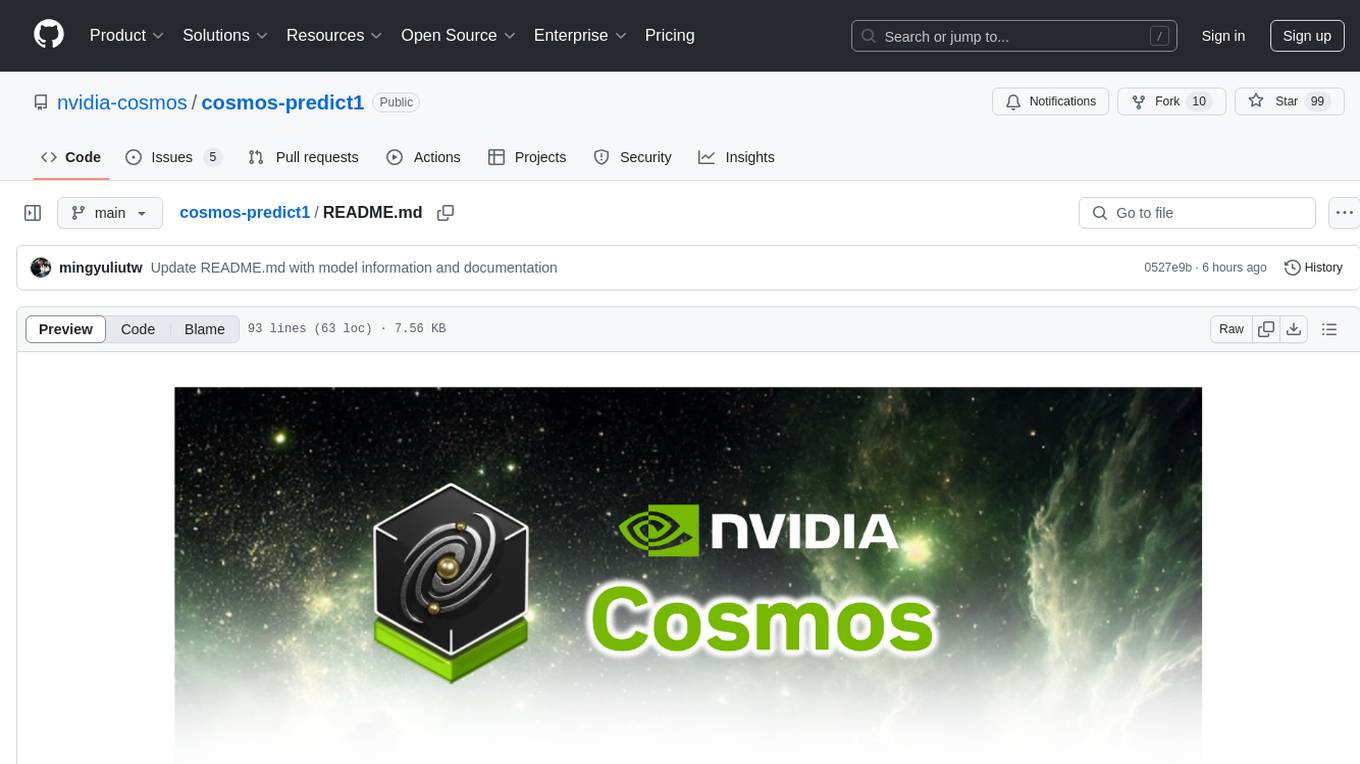
Cosmos-Predict1 is a specialized branch of Cosmos World Foundation Models (WFMs) focused on future state prediction, offering diffusion-based and autoregressive-based world foundation models for Text2World and Video2World generation. It includes image and video tokenizers for efficient tokenization, along with post-training and pre-training scripts for Physical AI builders. The tool provides various models for different tasks such as text to visual world generation, video-based future visual world generation, and tokenization of images and videos.
README:
Cosmos-Predict1 is a key branch of Cosmos World Foundation Models (WFMs) specialized for future state prediction, often referred to as world models. The tree main branches of Cosmos WFMs are cosmos-predict, cosmos-transfer, and cosmos-reason. We visualize the architecture of Cosmos-Predict1 in the following figure.
Cosmos-Predict1 includes the following:
- Diffusion-based world foundation models for Text2World and Video2World generation, where a user can generate visual simulation based on text prompts and video prompts.
- Autoregressive-based world foundation models for Video2World generation, where a user can generate visual simulation based on video prompts and optional text prompts.
- Image and video tokenizers for tokenizing videos into continuous tokens (latent vectors) and discrete tokens (integers) efficiently and effectively.
- Post-training scripts for helping Physical AI builders post-train pre-trained Cosmos-Predict1 for their applications.
- Pre-training scripts for helping Physical AI builders train their WFMs from scratch.
Your browser does not support the video tag.
Your browser does not support the video tag.
We provide a comphrehensive set of examples to illustrate how to perform inference, post-training, etc, with Cosmos-Predict1. Click a relevant example below and start your Cosmos journey.
Please refer to INSTALL.md for general instructions on environment setup.
- Inference with diffusion-based Text2World models [with multi-GPU support]
- Inference with diffusion-based Video2World models [with multi-GPU support]
- Inference with autoregressive-based base models [with multi-GPU support]
- Inference with autoregressive-based Video2World models [with multi-GPU support]
- Inference with tokenizer models
- Post-train diffusion-based Text2World models using custom datasets [with multi-node support]
- Post-train diffusion-based Video2World models using custom datasets [with multi-node support]
- Post-train diffusion-based Text2World models using custom multi-view datasets [with multi-node support]
- Post-train diffusion-based Video2World models using custom multi-view datasets) [with multi-node support]
- Post-train autoregressive-based base models using custom datasets [with multi-node support]
- Post-train tokenizers using custom datasets [with multi-node support]
- Inference with post-trained multi-view diffusion-based Text2World models) [with multi-GPU support]
- Inference with post-trained multi-view diffusion-based Video2World models) [with multi-GPU support]
Cosmos-Predict1 include the following models
Diffusion models
- Cosmos-Predict1-7B-Text2World: Text to visual world generation
- Cosmos-Predict1-14B-Text2World: Text to visual world generation
- Cosmos-Predict1-7B-Video2World: Video + Text based future visual world generation
- Cosmos-Predict1-14B-Video2World: Video + Text based future visual world generation
Autoregressive models
- Cosmos-Predict1-4B: Future visual world generation
- Cosmos-Predict1-12B: Future visual world generation
- Cosmos-Predict1-5B-Video2World: Video + Text based future visual world generation
- Cosmos-Predict1-13B-Video2World: Video + Text based future visual world generation
Tokenizers
- Cosmos-Tokenize1-CV8×8×8-720p: Continuous Video Tokenizer with 8x8x8 spatio-temporal compression with, 121 frames context
- Cosmos-Tokenize1-DV8×16×16-720p: Discrete Video Tokenizer with 8x16x16 spatio-temporal compression, and 49 frames context
- Cosmos-Tokenize1-CI8×8-360p: Continuous Image Tokenizer with 8x8 spatial compression with low-resolution support
- Cosmos-Tokenize1-CI16x16-360p: Continuous Image Tokenizer with 16x16 spatial compression with low-resolution support
- Cosmos-Tokenize1-CV4×8×8-360p: Continuous Video Tokenizer with 4x8x8 spatio-temporal compression with low-resolution support
- Cosmos-Tokenize1-DI8×8-360p: Discrete Image Tokenizer with 8x8 spatial compression with low-resolution support
- Cosmos-Tokenize1-DI16x16-360p: Discrete Image Tokenizer with 16x16 spatial compression with low-resolution support
- Cosmos-Tokenize1-DV4×8×8-360p: Discrete Video Tokenizer with 4x8x8 spatio-temporal compression with low-resolution support
This project will download and install additional third-party open source software projects. Review the license terms of these open source projects before use.
NVIDIA Cosmos source code is released under the Apache 2 License.
NVIDIA Cosmos models are released under the NVIDIA Open Model License. For a custom license (such as exemption of guardrail), please contact [email protected].
For Tasks:
Click tags to check more tools for each tasksFor Jobs:
Alternative AI tools for cosmos-predict1
Similar Open Source Tools

cosmos-predict1
Cosmos-Predict1 is a specialized branch of Cosmos World Foundation Models (WFMs) focused on future state prediction, offering diffusion-based and autoregressive-based world foundation models for Text2World and Video2World generation. It includes image and video tokenizers for efficient tokenization, along with post-training and pre-training scripts for Physical AI builders. The tool provides various models for different tasks such as text to visual world generation, video-based future visual world generation, and tokenization of images and videos.

rlhf_thinking_model
This repository is a collection of research notes and resources focusing on training large language models (LLMs) and Reinforcement Learning from Human Feedback (RLHF). It includes methodologies, techniques, and state-of-the-art approaches for optimizing preferences and model alignment in LLM training. The purpose is to serve as a reference for researchers and engineers interested in reinforcement learning, large language models, model alignment, and alternative RL-based methods.
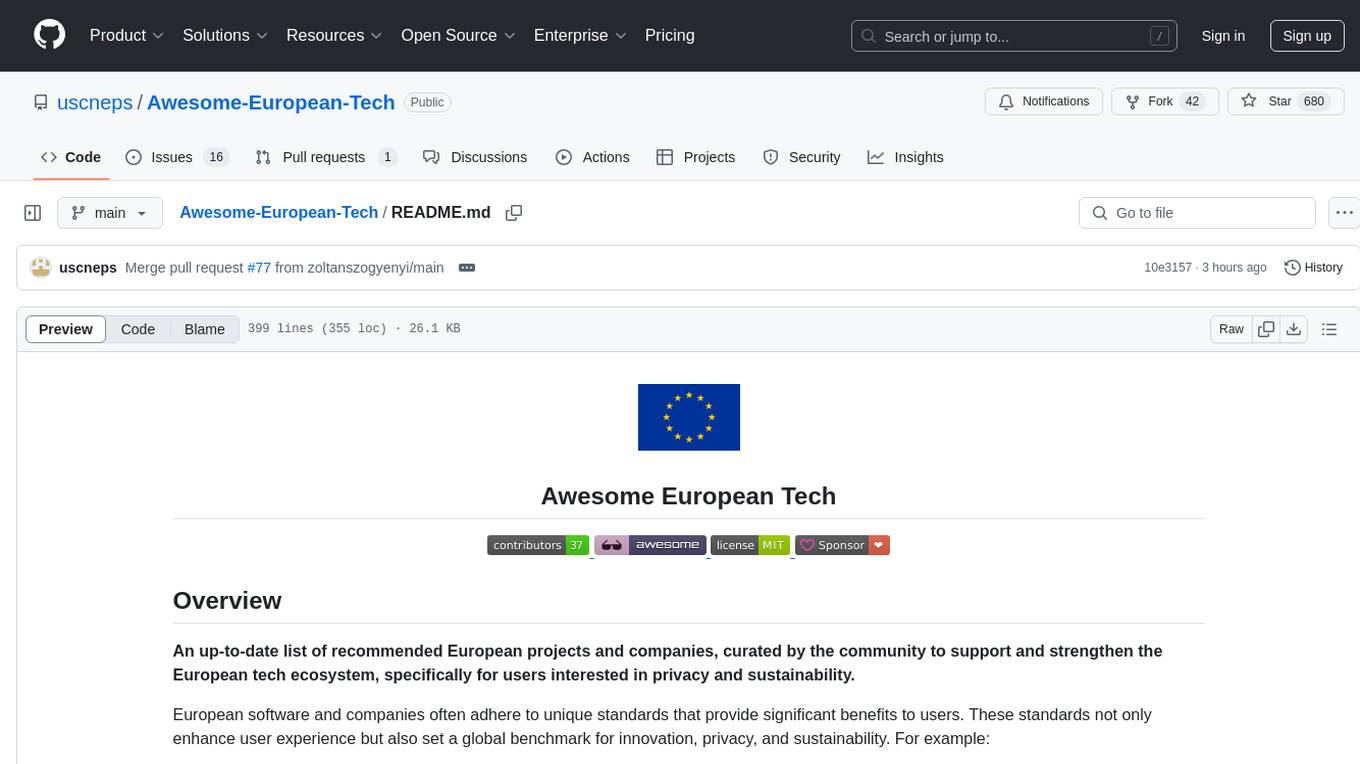
Awesome-European-Tech
Awesome European Tech is an up-to-date list of recommended European projects and companies curated by the community to support and strengthen the European tech ecosystem. It focuses on privacy and sustainability, showcasing companies that adhere to GDPR compliance and sustainability standards. The project aims to highlight and support European startups and projects excelling in privacy, sustainability, and innovation to contribute to a more diverse, resilient, and interconnected global tech landscape.

NZT-Poker-AI-Bot-17-Rooms-Cash-Fish-Monitor
The NZT Poker AI Bot is an advanced tool designed to revolutionize poker gameplay by providing comprehensive features to dominate 17 rooms with the Cash Fish Monitor. It offers detailed analysis of opponents' VPIP and PFR, extensive hand history database, opponent exploitation techniques, data-driven intelligence, player profiles, advanced neural network technology, expert training, continuous refinement, and cutting-edge algorithms for maximizing poker profits. Created by a team of poker experts, this AI tool continuously adapts to the latest poker strategies and utilizes state-of-the-art technology to enhance decision-making prowess.

joliGEN
JoliGEN is an integrated framework for training custom generative AI image-to-image models. It implements GAN, Diffusion, and Consistency models for various image translation tasks, including domain and style adaptation with conservation of semantics. The tool is designed for real-world applications such as Controlled Image Generation, Augmented Reality, Dataset Smart Augmentation, and Synthetic to Real transforms. JoliGEN allows for fast and stable training with a REST API server for simplified deployment. It offers a wide range of options and parameters with detailed documentation available for models, dataset formats, and data augmentation.
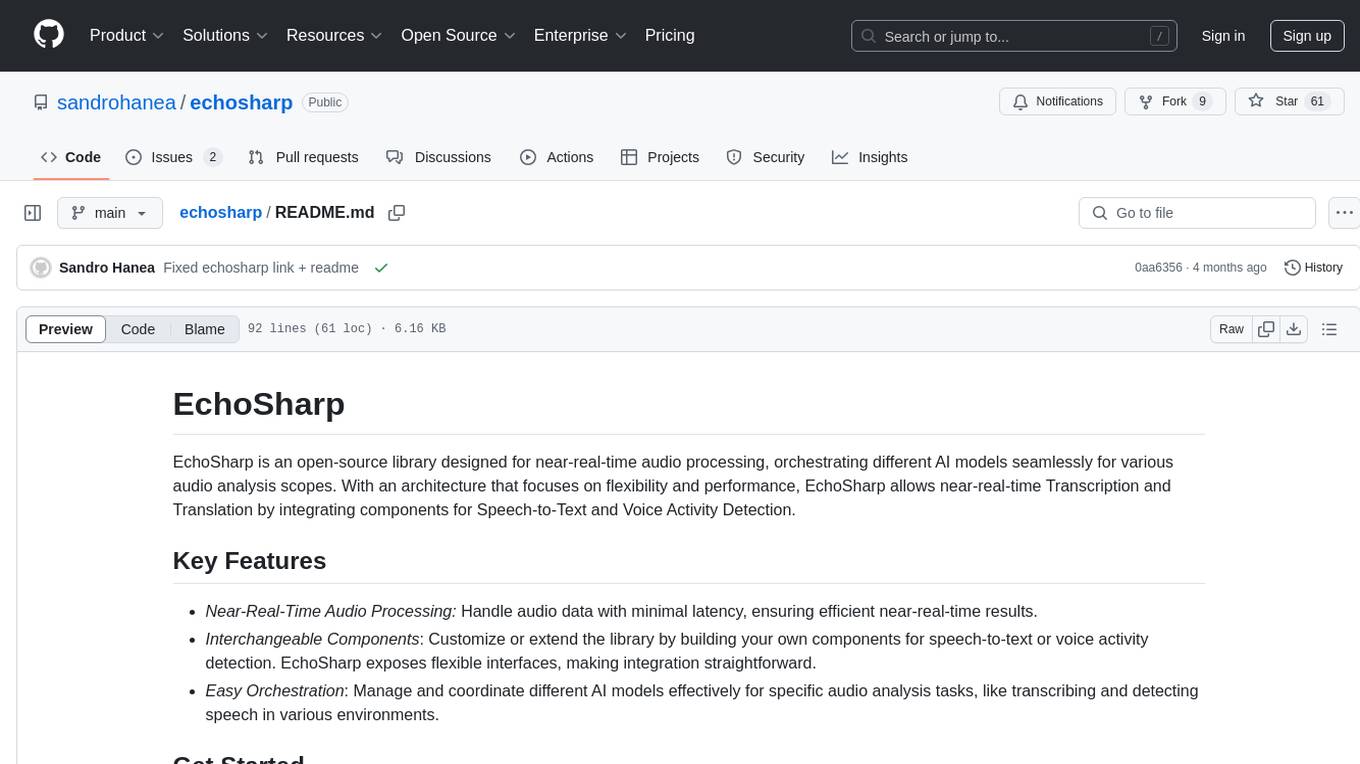
echosharp
EchoSharp is an open-source library designed for near-real-time audio processing, orchestrating different AI models seamlessly for various audio analysis scopes. It focuses on flexibility and performance, allowing near-real-time Transcription and Translation by integrating components for Speech-to-Text and Voice Activity Detection. With interchangeable components, easy orchestration, and first-party components like Whisper.net, SileroVad, OpenAI Whisper, AzureAI SpeechServices, WebRtcVadSharp, Onnx.Whisper, and Onnx.Sherpa, EchoSharp provides efficient audio analysis solutions for developers.
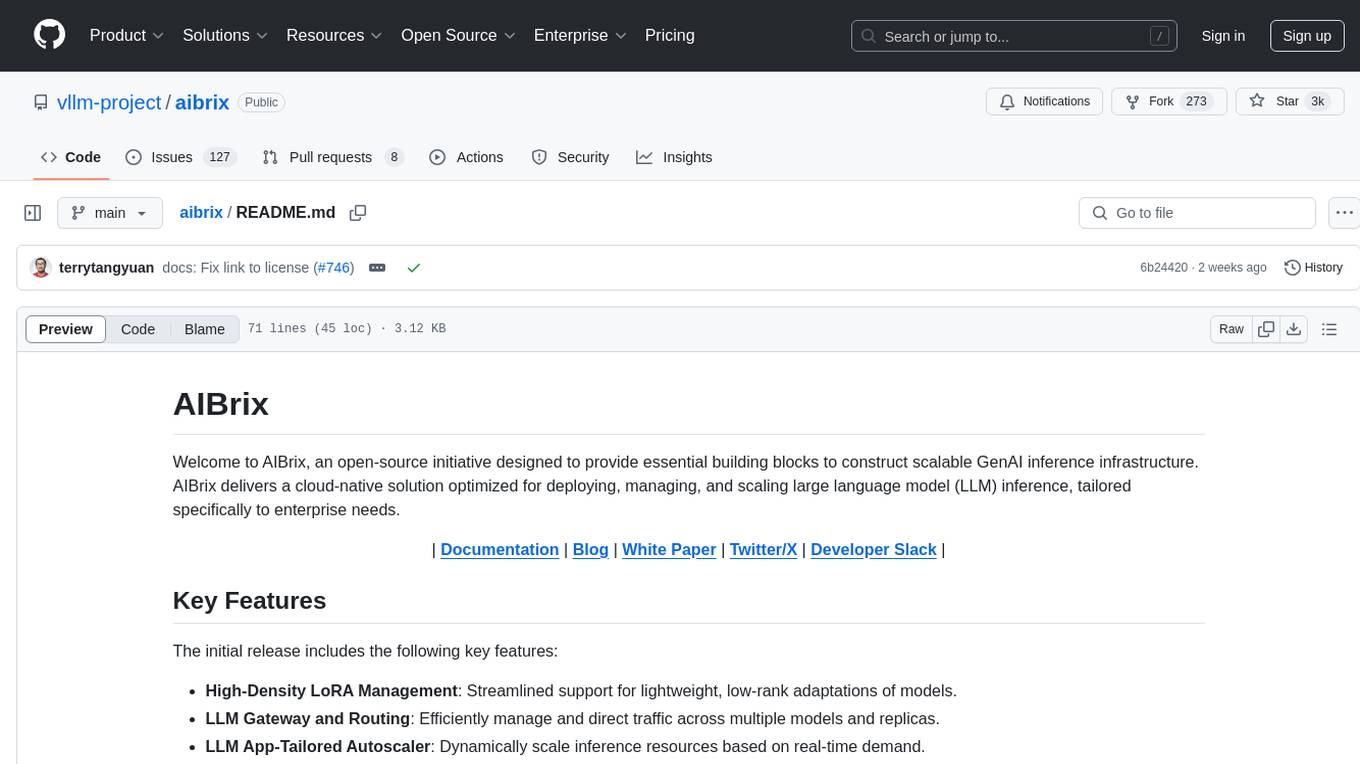
aibrix
AIBrix is an open-source initiative providing essential building blocks for scalable GenAI inference infrastructure. It delivers a cloud-native solution optimized for deploying, managing, and scaling large language model (LLM) inference, tailored to enterprise needs. Key features include High-Density LoRA Management, LLM Gateway and Routing, LLM App-Tailored Autoscaler, Unified AI Runtime, Distributed Inference, Distributed KV Cache, Cost-efficient Heterogeneous Serving, and GPU Hardware Failure Detection.
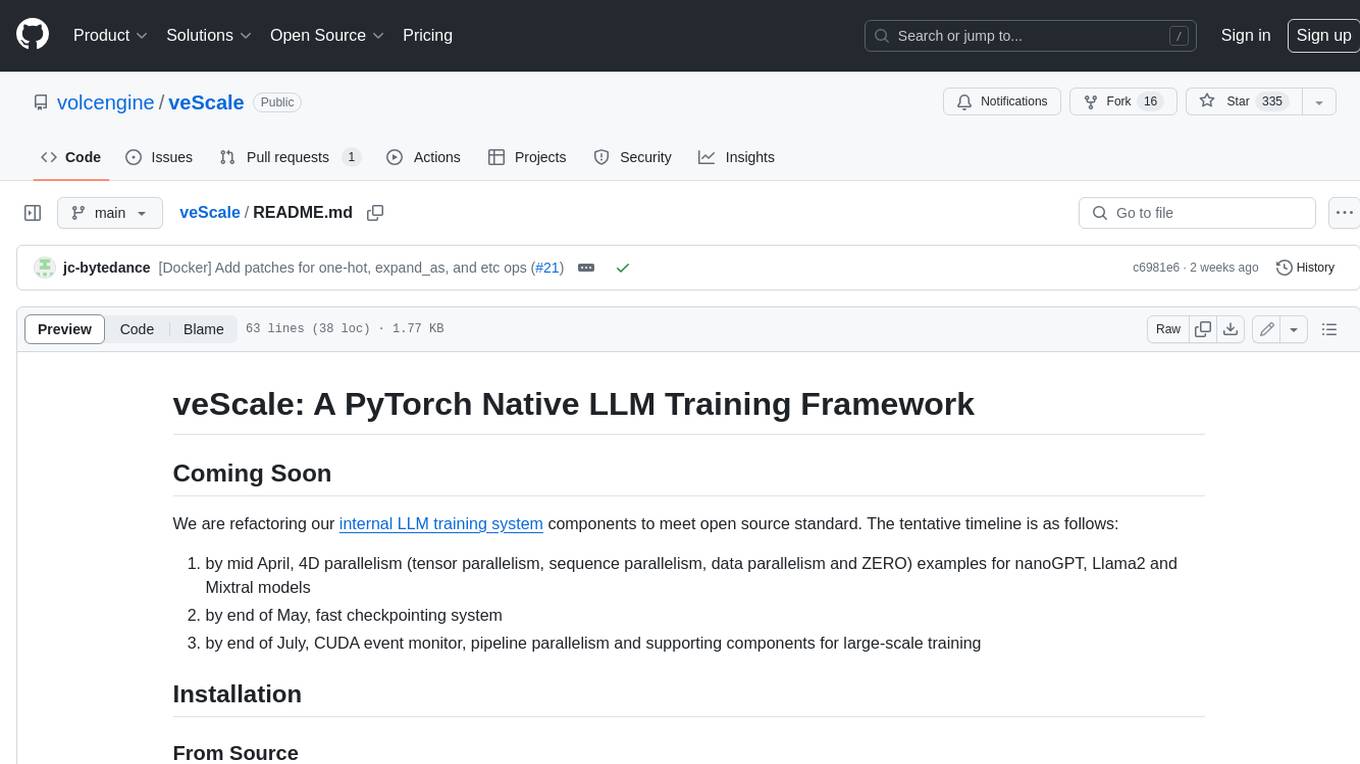
veScale
veScale is a PyTorch Native LLM Training Framework. It provides a set of tools and components to facilitate the training of large language models (LLMs) using PyTorch. veScale includes features such as 4D parallelism, fast checkpointing, and a CUDA event monitor. It is designed to be scalable and efficient, and it can be used to train LLMs on a variety of hardware platforms.
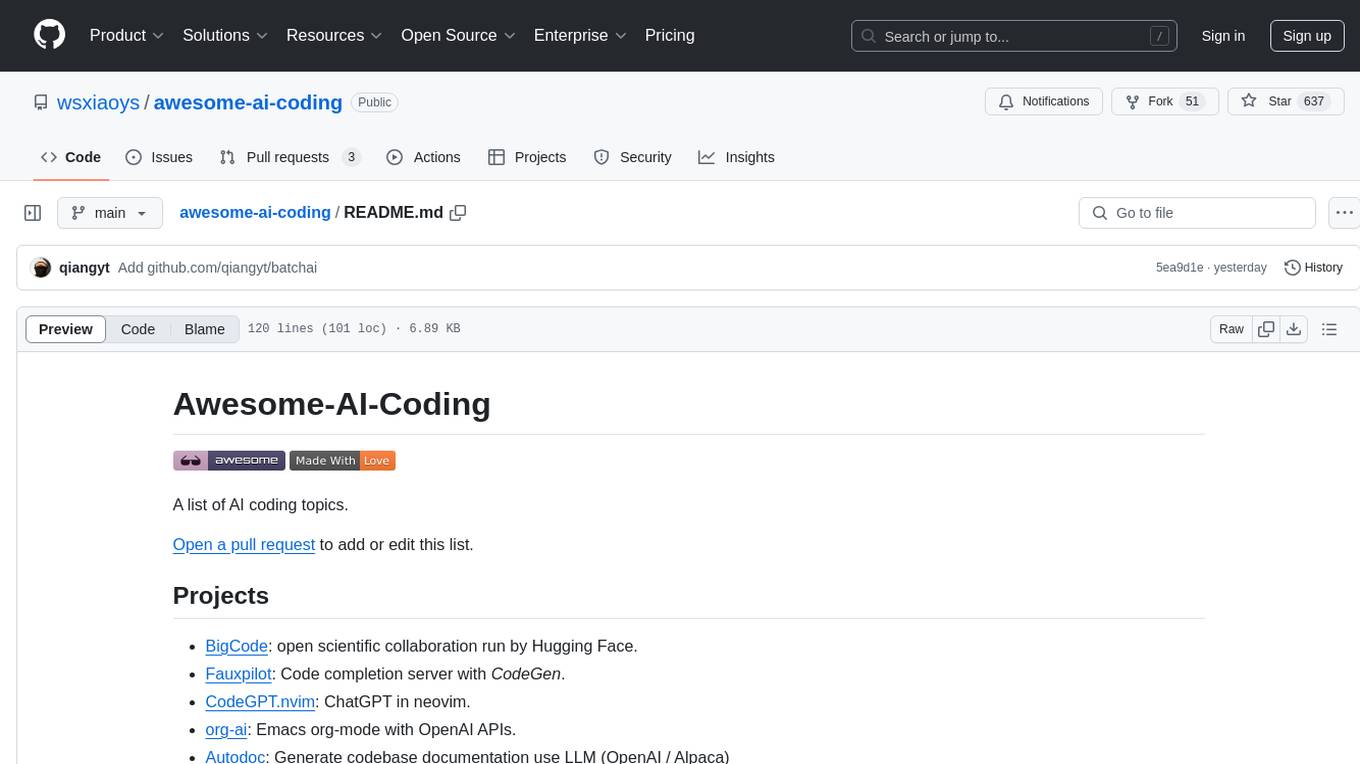
awesome-ai-coding
Awesome-AI-Coding is a curated list of AI coding topics, projects, datasets, LLM models, embedding models, papers, blogs, products, startups, and peer awesome lists related to artificial intelligence in coding. It includes tools for code completion, code generation, code documentation, and code search, as well as AI models and techniques for improving developer productivity. The repository also features information on various AI-powered developer tools, copilots, and related resources in the AI coding domain.
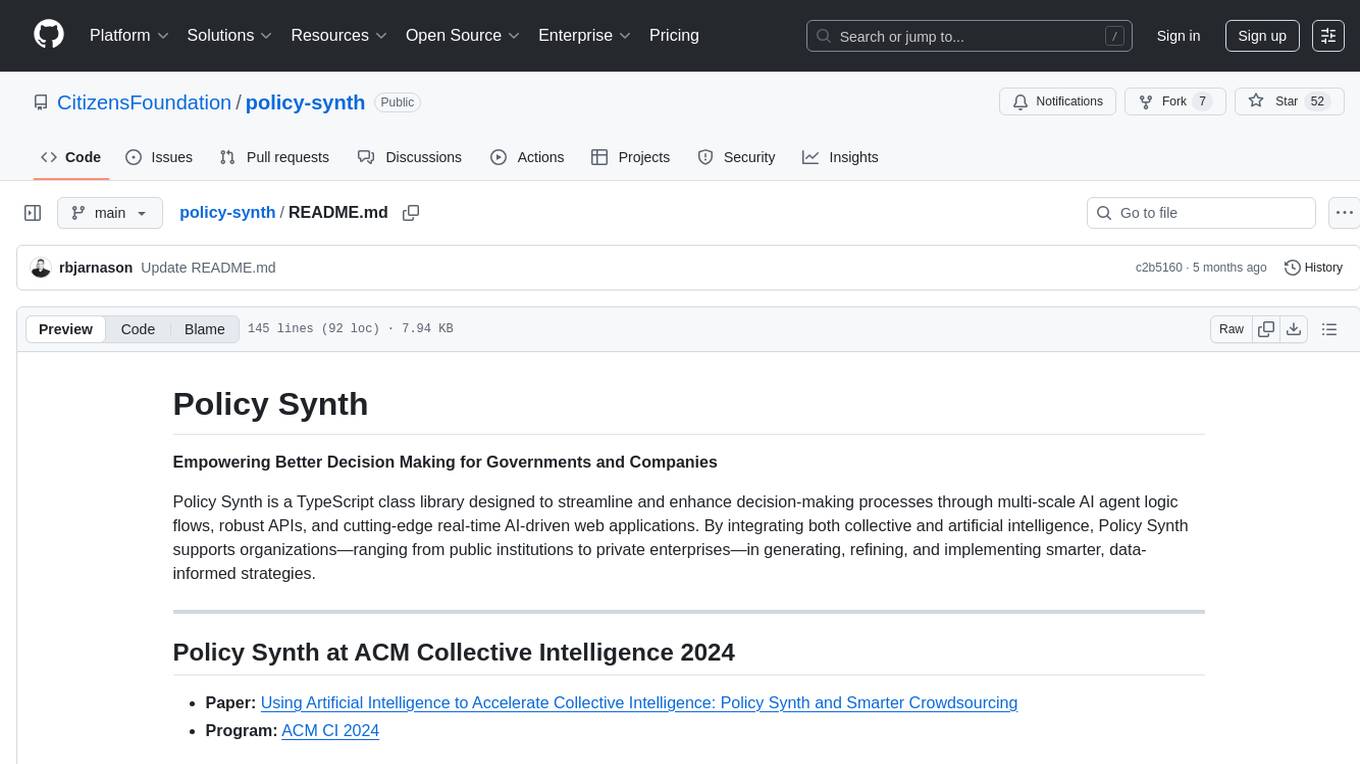
policy-synth
Policy Synth is a TypeScript class library that empowers better decision-making for governments and companies by integrating collective and artificial intelligence. It streamlines processes through multi-scale AI agent logic flows, robust APIs, and cutting-edge real-time AI-driven web applications. The tool supports organizations in generating, refining, and implementing smarter, data-informed strategies, fostering collaboration with AI to tackle complex challenges effectively.

Awesome-Embedded
Awesome-Embedded is a curated list of resources for embedded systems enthusiasts. It covers a wide range of topics including MCU programming, RTOS, Linux kernel development, assembly programming, machine learning & AI on MCU, utilities, tips & tricks, and more. The repository provides valuable information, tutorials, and tools for individuals interested in embedded systems development.
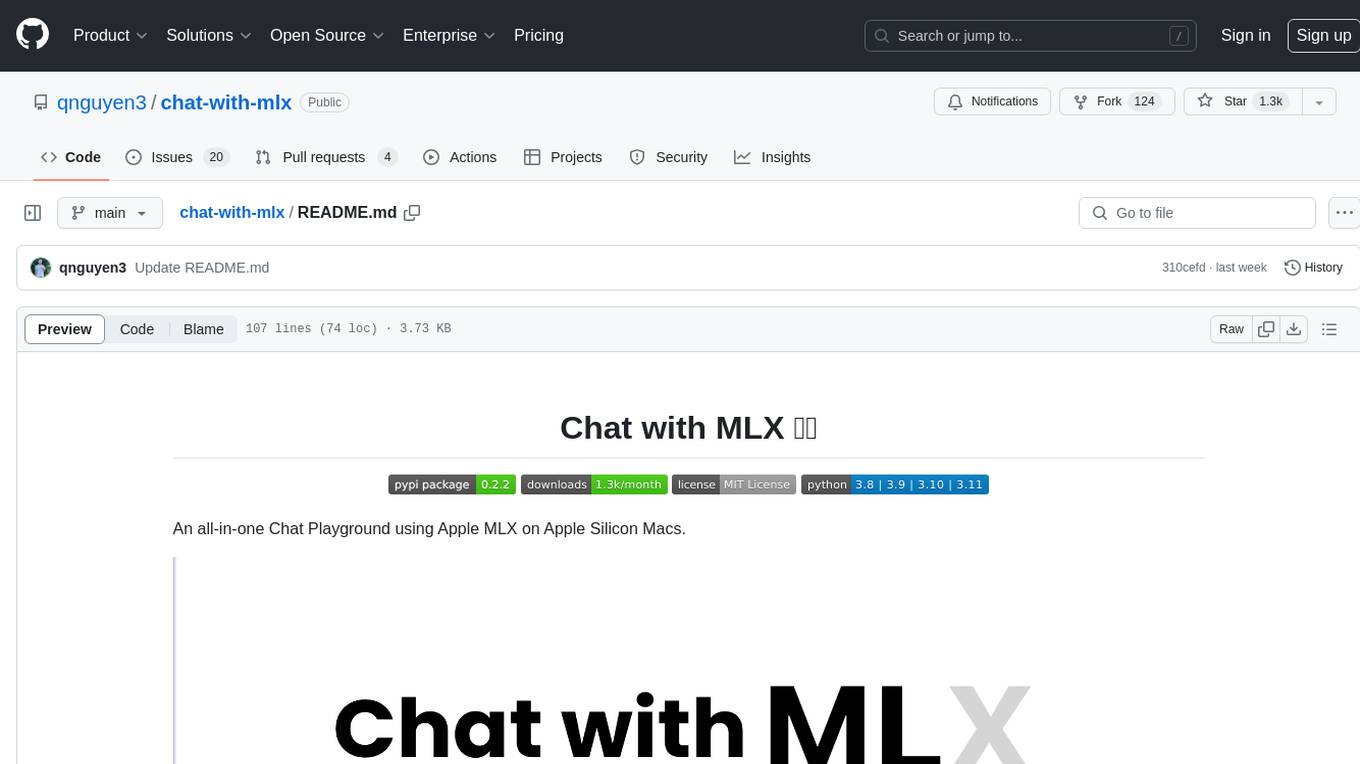
chat-with-mlx
Chat with MLX is an all-in-one Chat Playground using Apple MLX on Apple Silicon Macs. It provides privacy-enhanced AI for secure conversations with various models, easy integration of HuggingFace and MLX Compatible Open-Source Models, and comes with default models like Llama-3, Phi-3, Yi, Qwen, Mistral, Codestral, Mixtral, StableLM. The tool is designed for developers and researchers working with machine learning models on Apple Silicon.
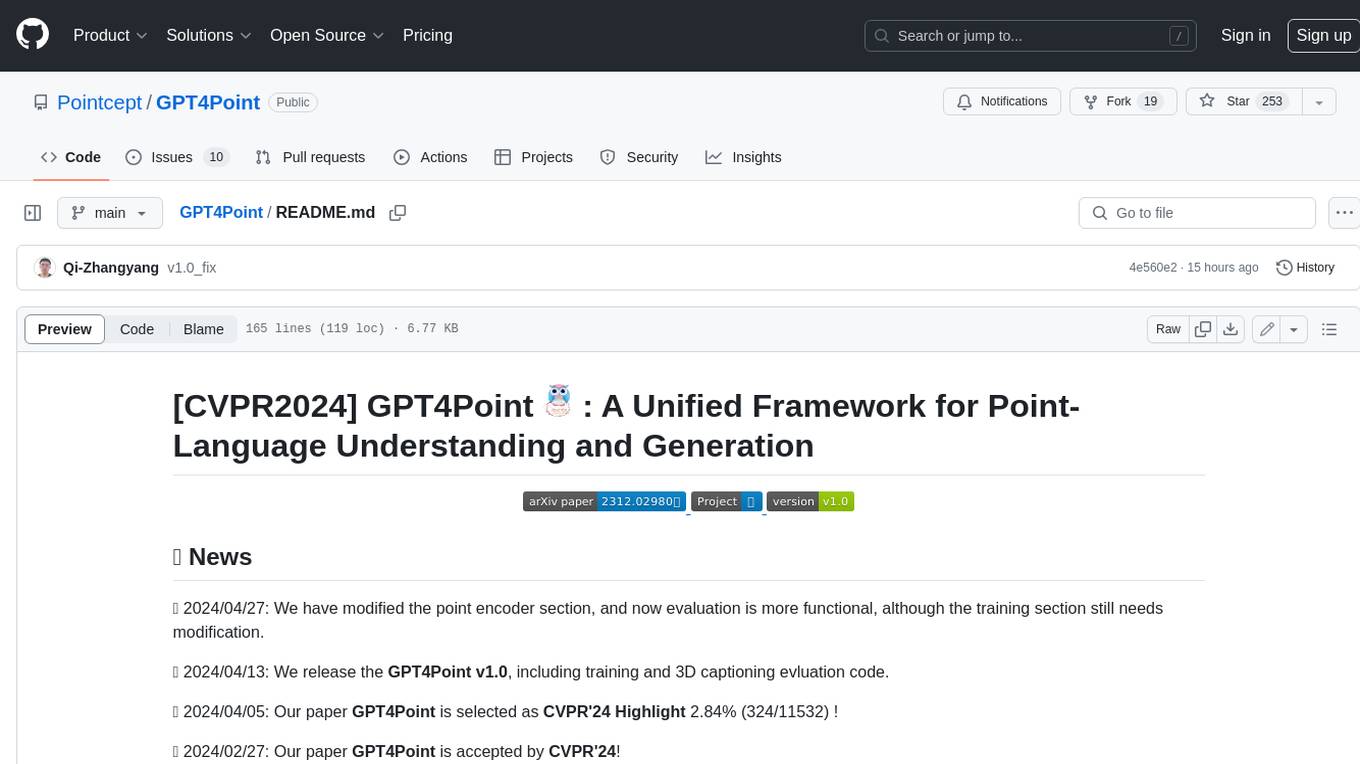
GPT4Point
GPT4Point is a unified framework for point-language understanding and generation. It aligns 3D point clouds with language, providing a comprehensive solution for tasks such as 3D captioning and controlled 3D generation. The project includes an automated point-language dataset annotation engine, a novel object-level point cloud benchmark, and a 3D multi-modality model. Users can train and evaluate models using the provided code and datasets, with a focus on improving models' understanding capabilities and facilitating the generation of 3D objects.
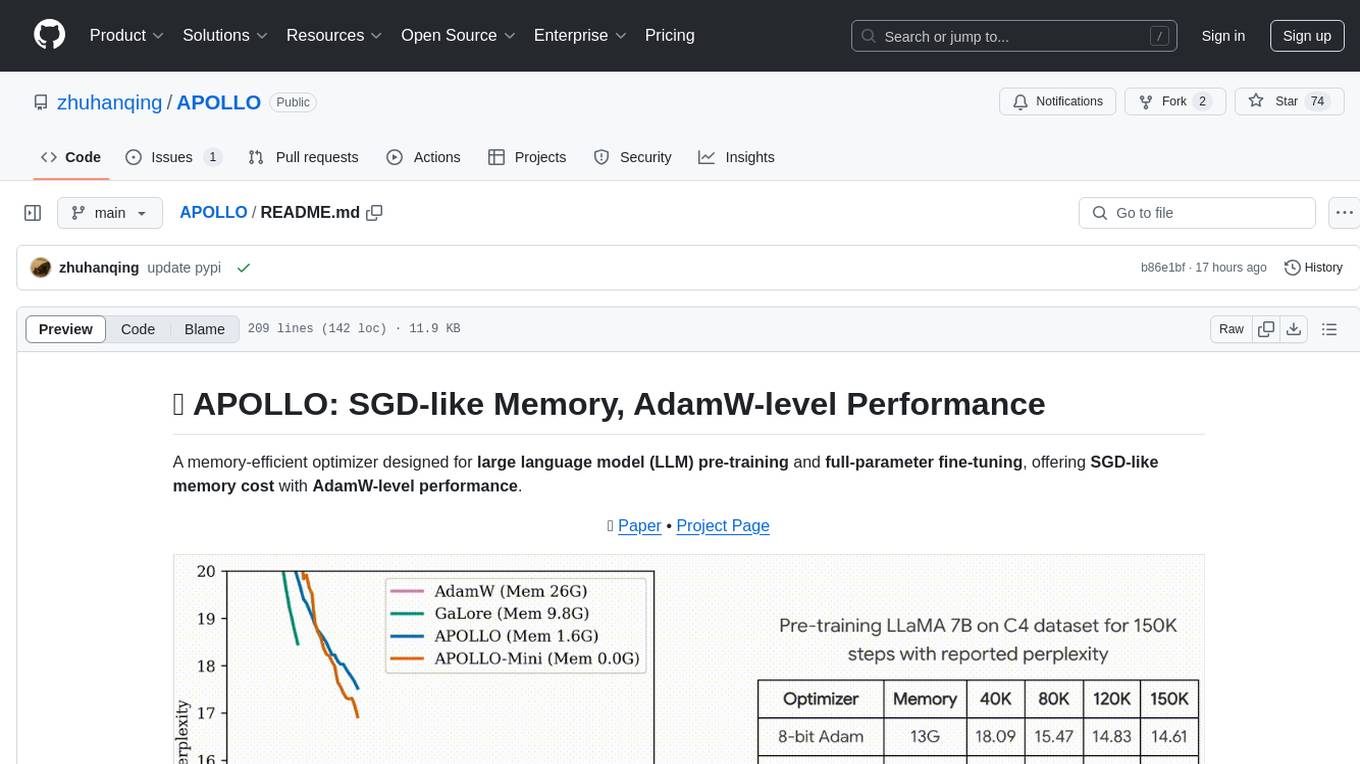
APOLLO
APOLLO is a memory-efficient optimizer designed for large language model (LLM) pre-training and full-parameter fine-tuning. It offers SGD-like memory cost with AdamW-level performance. The optimizer integrates low-rank approximation and optimizer state redundancy reduction to achieve significant memory savings while maintaining or surpassing the performance of Adam(W). Key contributions include structured learning rate updates for LLM training, approximated channel-wise gradient scaling in a low-rank auxiliary space, and minimal-rank tensor-wise gradient scaling. APOLLO aims to optimize memory efficiency during training large language models.
For similar tasks

cosmos-predict1
Cosmos-Predict1 is a specialized branch of Cosmos World Foundation Models (WFMs) focused on future state prediction, offering diffusion-based and autoregressive-based world foundation models for Text2World and Video2World generation. It includes image and video tokenizers for efficient tokenization, along with post-training and pre-training scripts for Physical AI builders. The tool provides various models for different tasks such as text to visual world generation, video-based future visual world generation, and tokenization of images and videos.
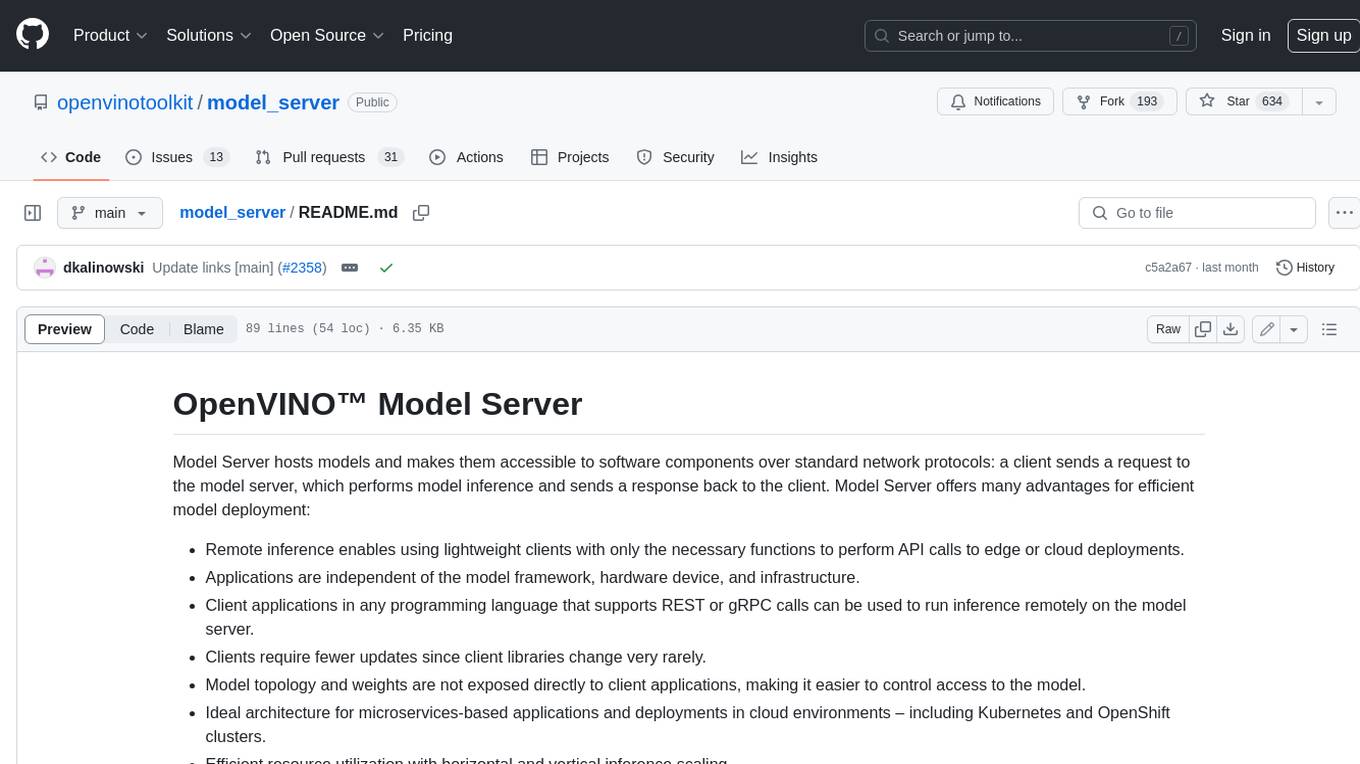
model_server
OpenVINO™ Model Server (OVMS) is a high-performance system for serving models. Implemented in C++ for scalability and optimized for deployment on Intel architectures, the model server uses the same architecture and API as TensorFlow Serving and KServe while applying OpenVINO for inference execution. Inference service is provided via gRPC or REST API, making deploying new algorithms and AI experiments easy.
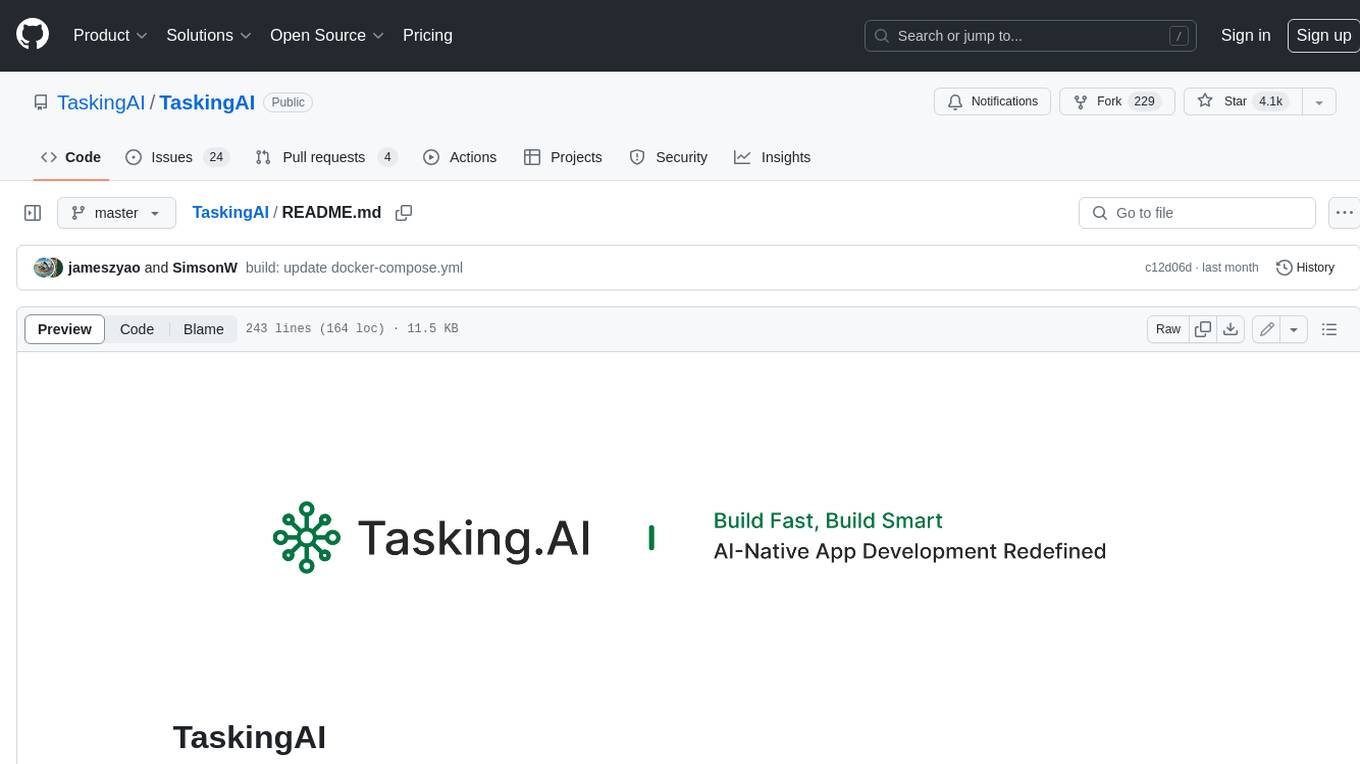
TaskingAI
TaskingAI brings Firebase's simplicity to **AI-native app development**. The platform enables the creation of GPTs-like multi-tenant applications using a wide range of LLMs from various providers. It features distinct, modular functions such as Inference, Retrieval, Assistant, and Tool, seamlessly integrated to enhance the development process. TaskingAI’s cohesive design ensures an efficient, intelligent, and user-friendly experience in AI application development.
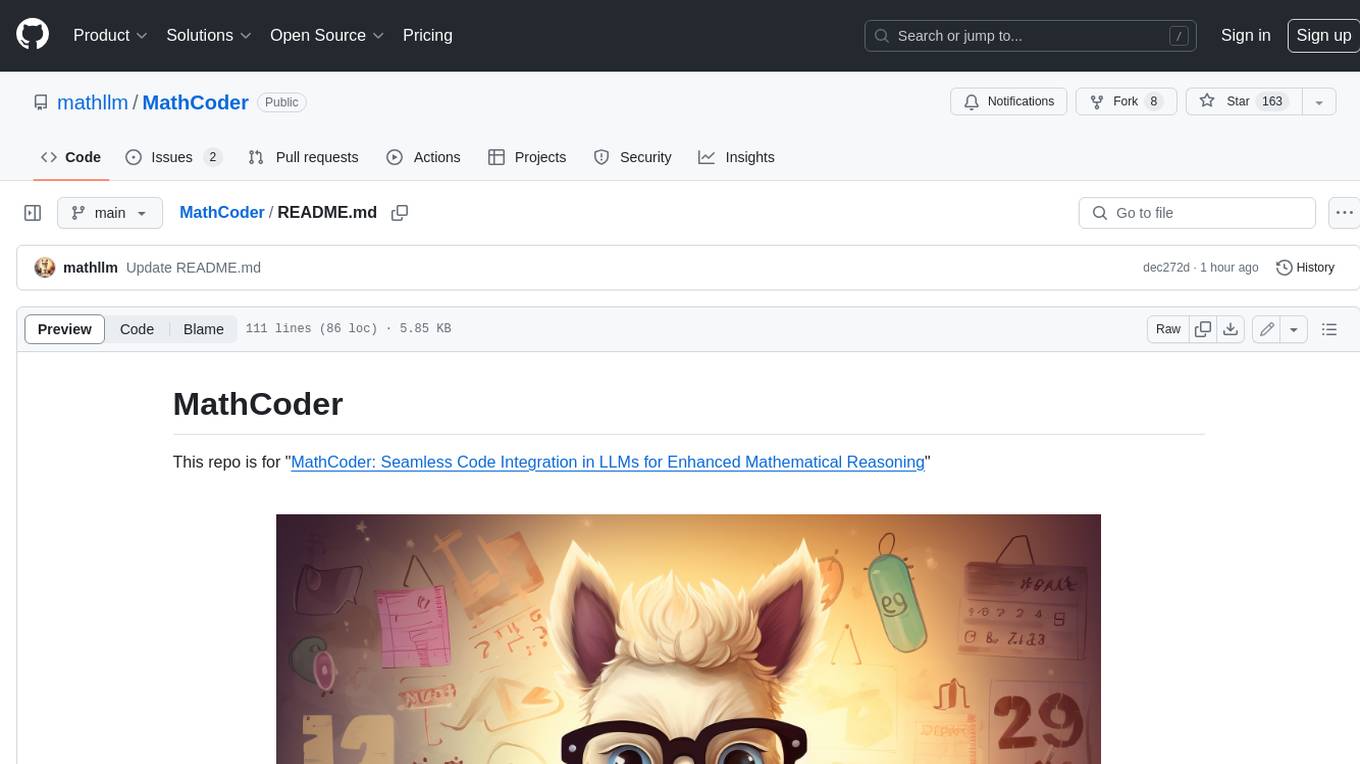
MathCoder
MathCoder is a repository focused on enhancing mathematical reasoning by fine-tuning open-source language models to use code for modeling and deriving math equations. It introduces MathCodeInstruct dataset with solutions interleaving natural language, code, and execution results. The repository provides MathCoder models capable of generating code-based solutions for challenging math problems, achieving state-of-the-art scores on MATH and GSM8K datasets. It offers tools for model deployment, inference, and evaluation, along with a citation for referencing the work.
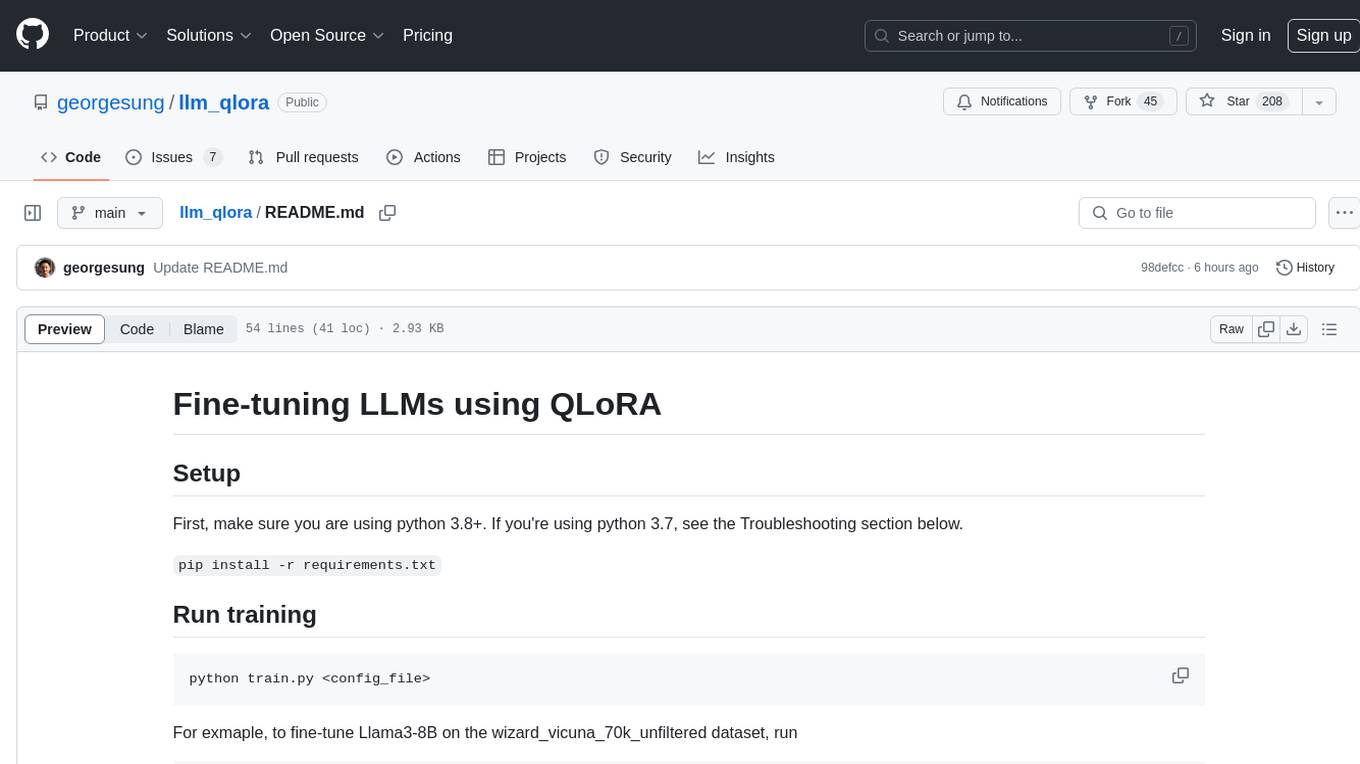
llm_qlora
LLM_QLoRA is a repository for fine-tuning Large Language Models (LLMs) using QLoRA methodology. It provides scripts for training LLMs on custom datasets, pushing models to HuggingFace Hub, and performing inference. Additionally, it includes models trained on HuggingFace Hub, a blog post detailing the QLoRA fine-tuning process, and instructions for converting and quantizing models. The repository also addresses troubleshooting issues related to Python versions and dependencies.
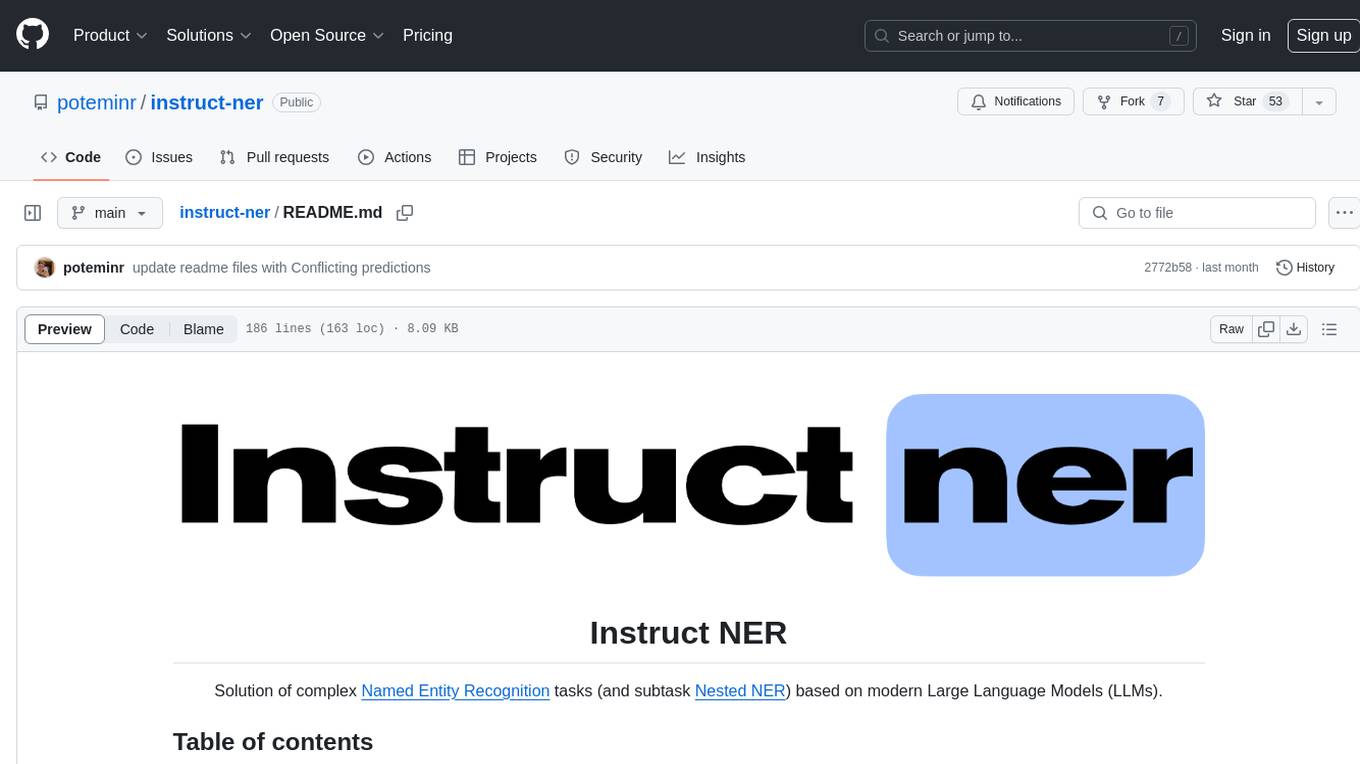
instruct-ner
Instruct NER is a solution for complex Named Entity Recognition tasks, including Nested NER, based on modern Large Language Models (LLMs). It provides tools for dataset creation, training, automatic metric calculation, inference, error analysis, and model implementation. Users can create instructions for LLM, build dictionaries with labels, and generate model input templates. The tool supports various entity types and datasets, such as RuDReC, NEREL-BIO, CoNLL-2003, and MultiCoNER II. It offers training scripts for LLMs and metric calculation functions. Instruct NER models like Llama, Mistral, T5, and RWKV are implemented, with HuggingFace models available for adaptation and merging.
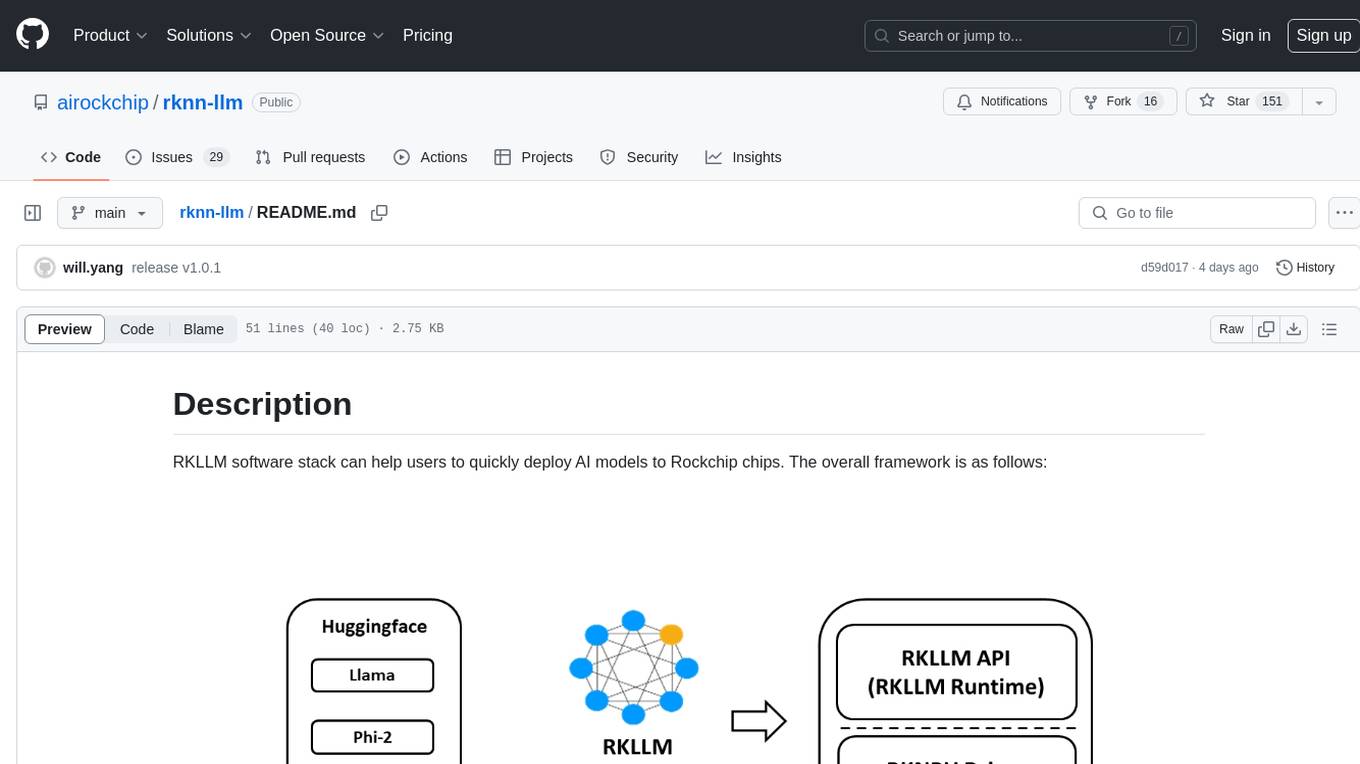
rknn-llm
RKLLM software stack is a toolkit designed to help users quickly deploy AI models to Rockchip chips. It consists of RKLLM-Toolkit for model conversion and quantization, RKLLM Runtime for deploying models on Rockchip NPU platform, and RKNPU kernel driver for hardware interaction. The toolkit supports RK3588 and RK3576 series chips and various models like TinyLLAMA, Qwen, Phi, ChatGLM3, Gemma, InternLM2, and MiniCPM. Users can download packages, docker images, examples, and docs from RKLLM_SDK. Additionally, RKNN-Toolkit2 SDK is available for deploying additional AI models.
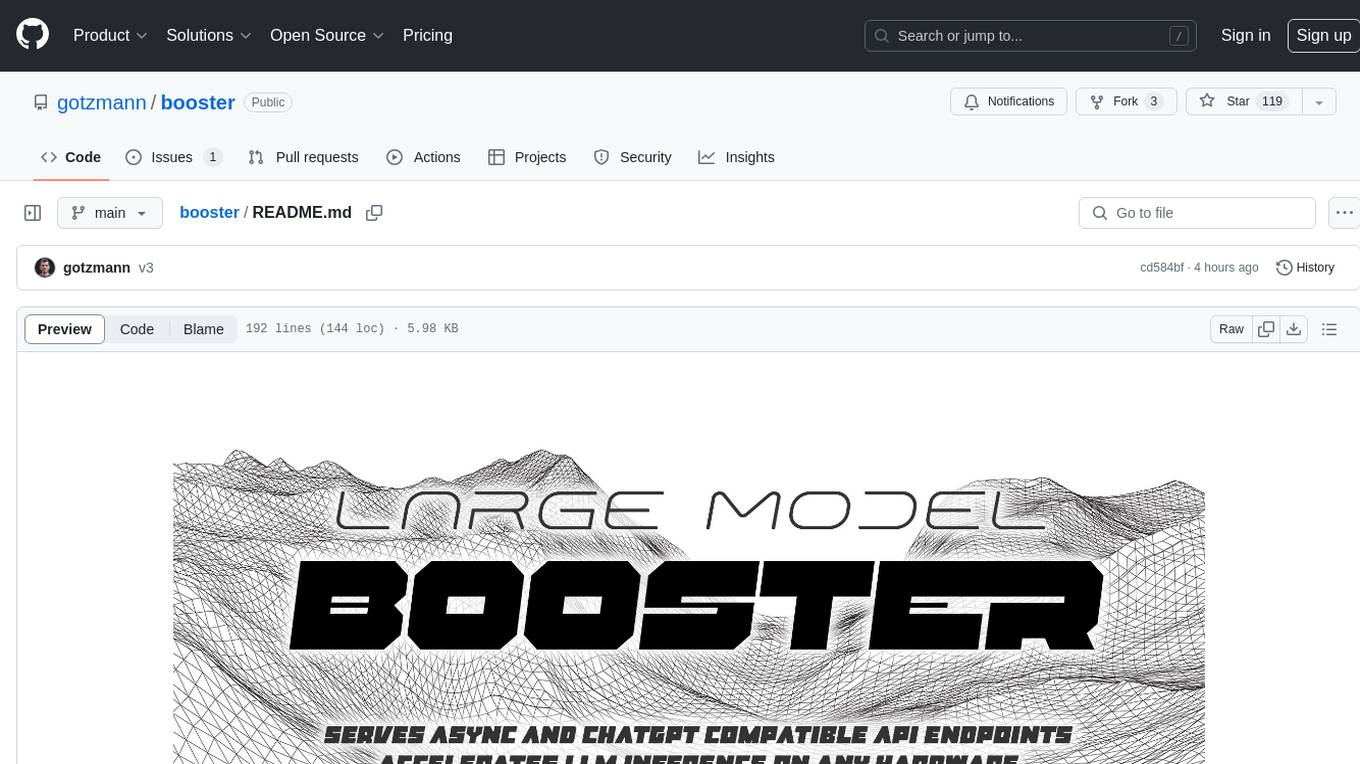
booster
Booster is a powerful inference accelerator designed for scaling large language models within production environments or for experimental purposes. It is built with performance and scaling in mind, supporting various CPUs and GPUs, including Nvidia CUDA, Apple Metal, and OpenCL cards. The tool can split large models across multiple GPUs, offering fast inference on machines with beefy GPUs. It supports both regular FP16/FP32 models and quantised versions, along with popular LLM architectures. Additionally, Booster features proprietary Janus Sampling for code generation and non-English languages.
For similar jobs
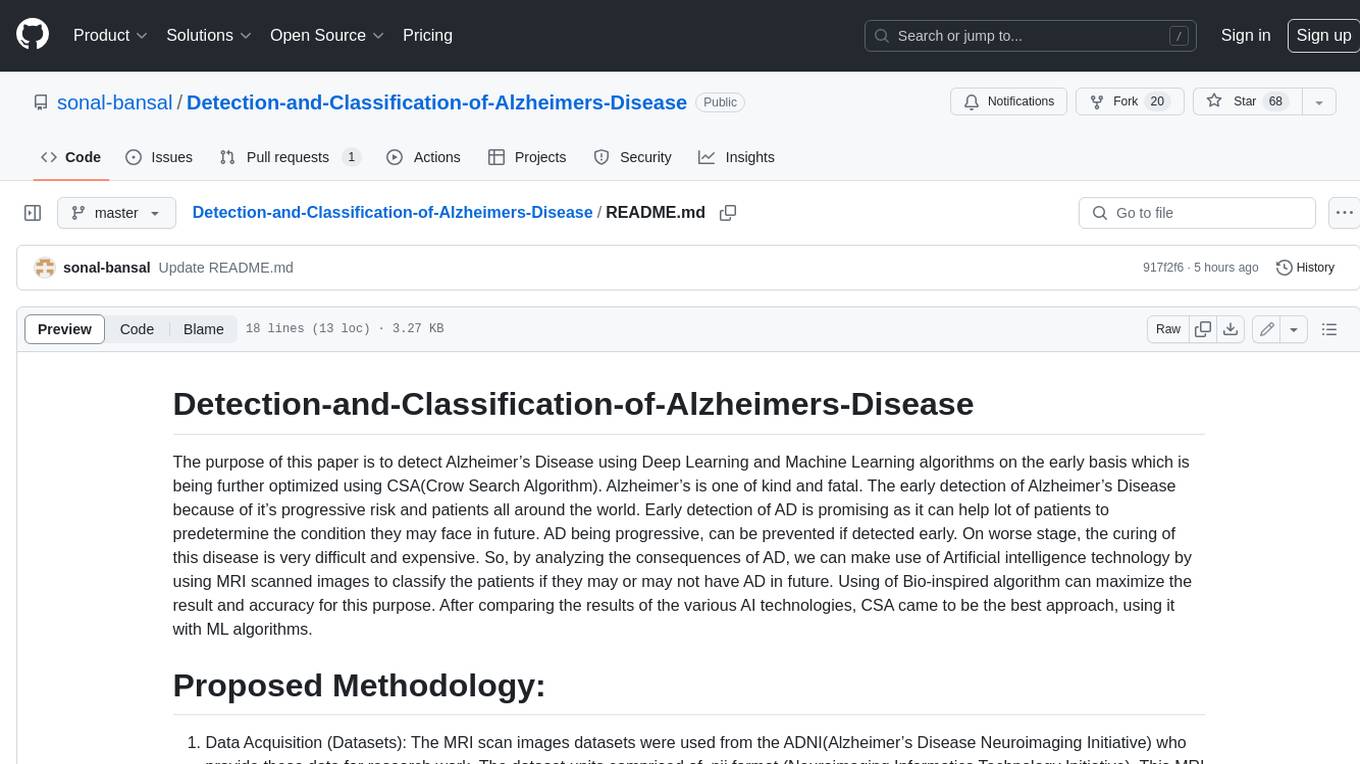
Detection-and-Classification-of-Alzheimers-Disease
This tool is designed to detect and classify Alzheimer's Disease using Deep Learning and Machine Learning algorithms on an early basis, which is further optimized using the Crow Search Algorithm (CSA). Alzheimer's is a fatal disease, and early detection is crucial for patients to predetermine their condition and prevent its progression. By analyzing MRI scanned images using Artificial Intelligence technology, this tool can classify patients who may or may not develop AD in the future. The CSA algorithm, combined with ML algorithms, has proven to be the most effective approach for this purpose.
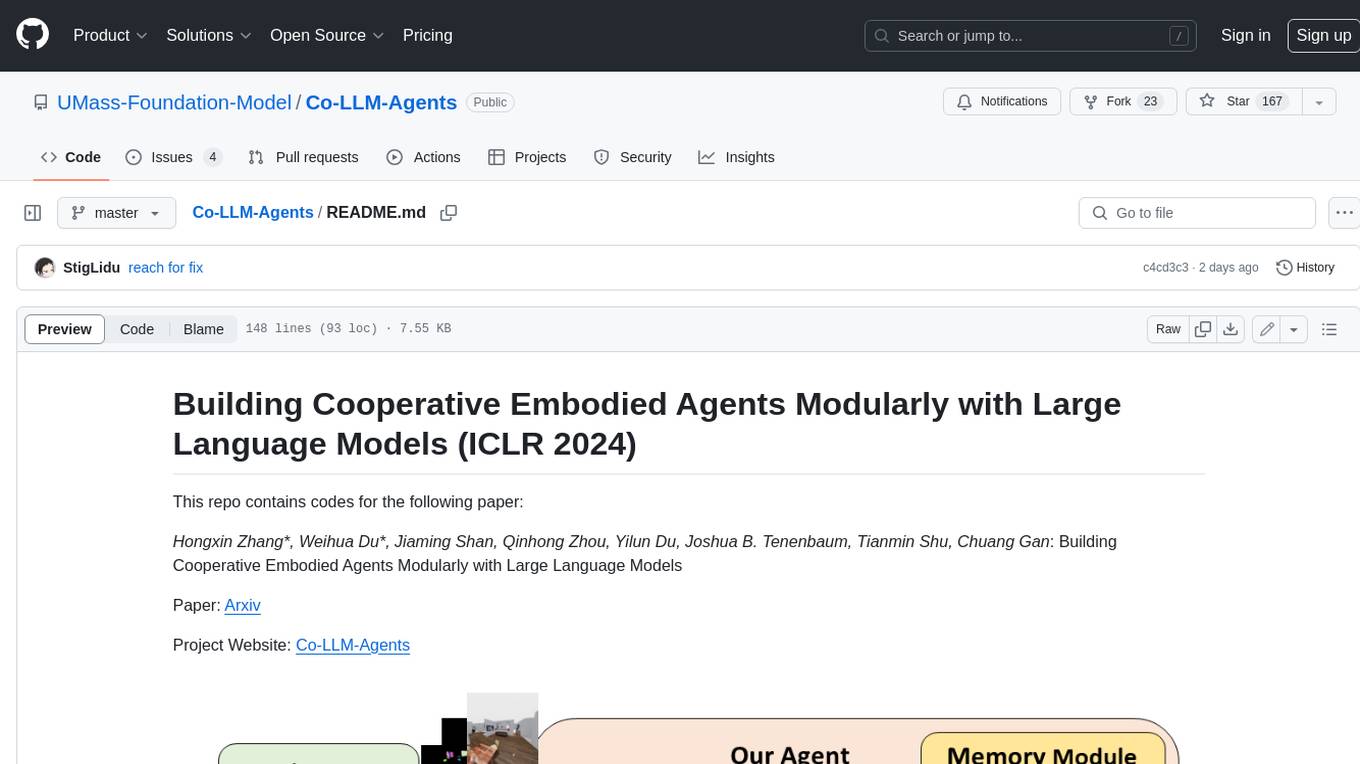
Co-LLM-Agents
This repository contains code for building cooperative embodied agents modularly with large language models. The agents are trained to perform tasks in two different environments: ThreeDWorld Multi-Agent Transport (TDW-MAT) and Communicative Watch-And-Help (C-WAH). TDW-MAT is a multi-agent environment where agents must transport objects to a goal position using containers. C-WAH is an extension of the Watch-And-Help challenge, which enables agents to send messages to each other. The code in this repository can be used to train agents to perform tasks in both of these environments.
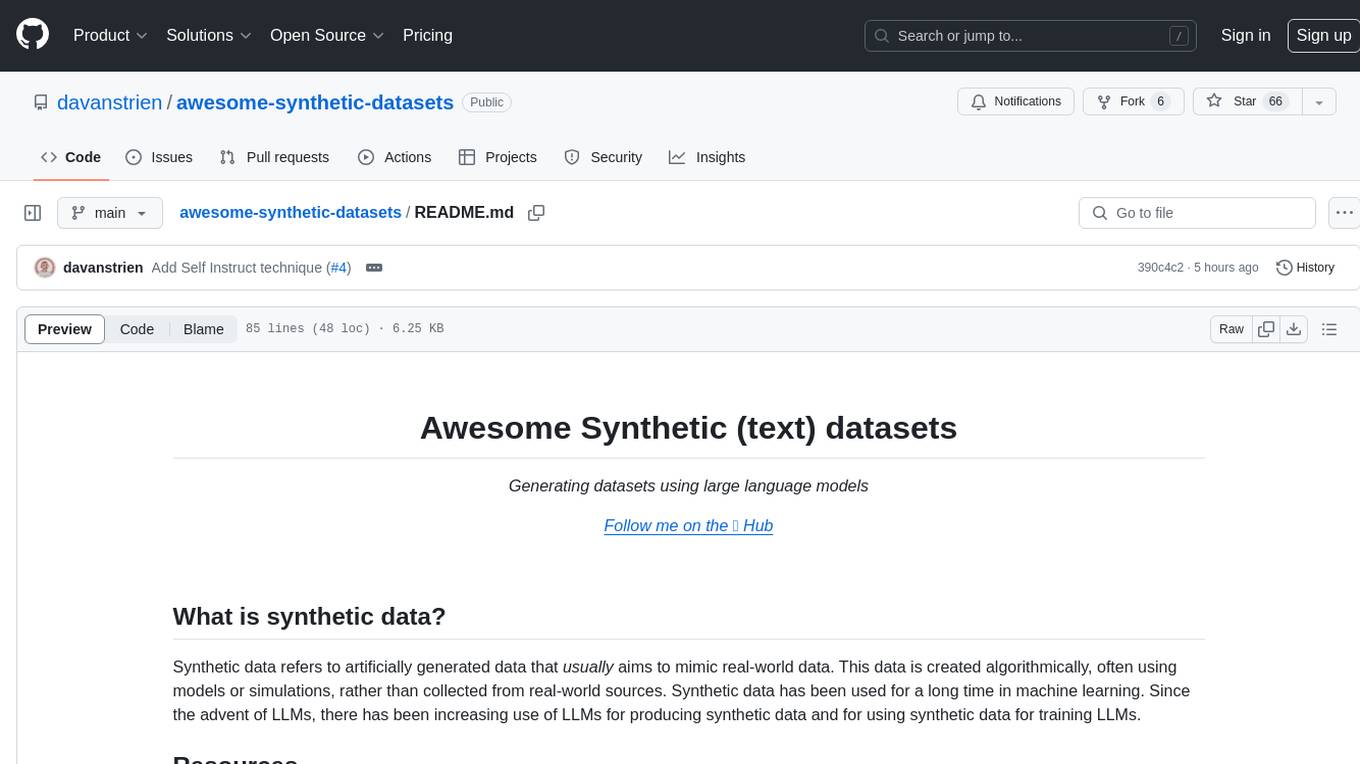
awesome-synthetic-datasets
This repository focuses on organizing resources for building synthetic datasets using large language models. It covers important datasets, libraries, tools, tutorials, and papers related to synthetic data generation. The goal is to provide pragmatic and practical resources for individuals interested in creating synthetic datasets for machine learning applications.

ai-devices
AI Devices Template is a project that serves as an AI-powered voice assistant utilizing various AI models and services to provide intelligent responses to user queries. It supports voice input, transcription, text-to-speech, image processing, and function calling with conditionally rendered UI components. The project includes customizable UI settings, optional rate limiting using Upstash, and optional tracing with Langchain's LangSmith for function execution. Users can clone the repository, install dependencies, add API keys, start the development server, and deploy the application. Configuration settings can be modified in `app/config.tsx` to adjust settings and configurations for the AI-powered voice assistant.
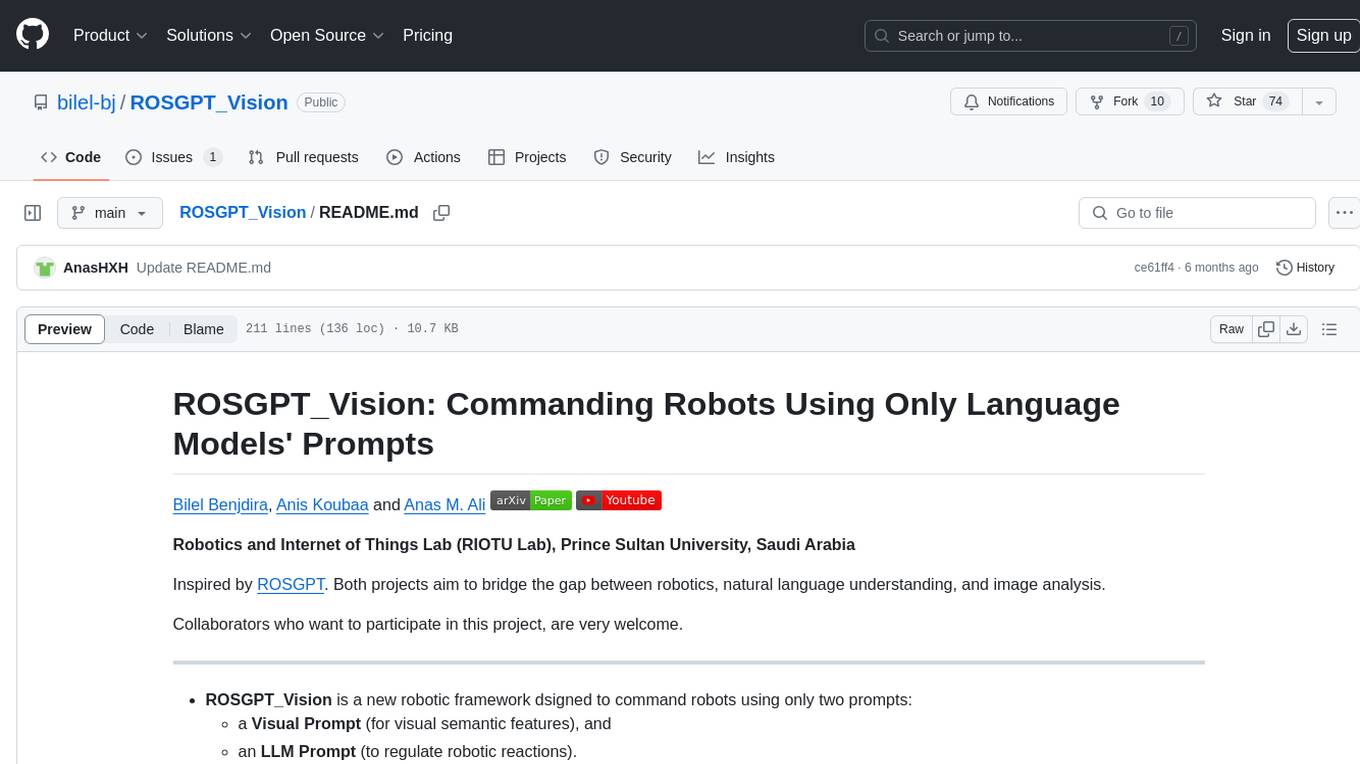
ROSGPT_Vision
ROSGPT_Vision is a new robotic framework designed to command robots using only two prompts: a Visual Prompt for visual semantic features and an LLM Prompt to regulate robotic reactions. It is based on the Prompting Robotic Modalities (PRM) design pattern and is used to develop CarMate, a robotic application for monitoring driver distractions and providing real-time vocal notifications. The framework leverages state-of-the-art language models to facilitate advanced reasoning about image data and offers a unified platform for robots to perceive, interpret, and interact with visual data through natural language. LangChain is used for easy customization of prompts, and the implementation includes the CarMate application for driver monitoring and assistance.
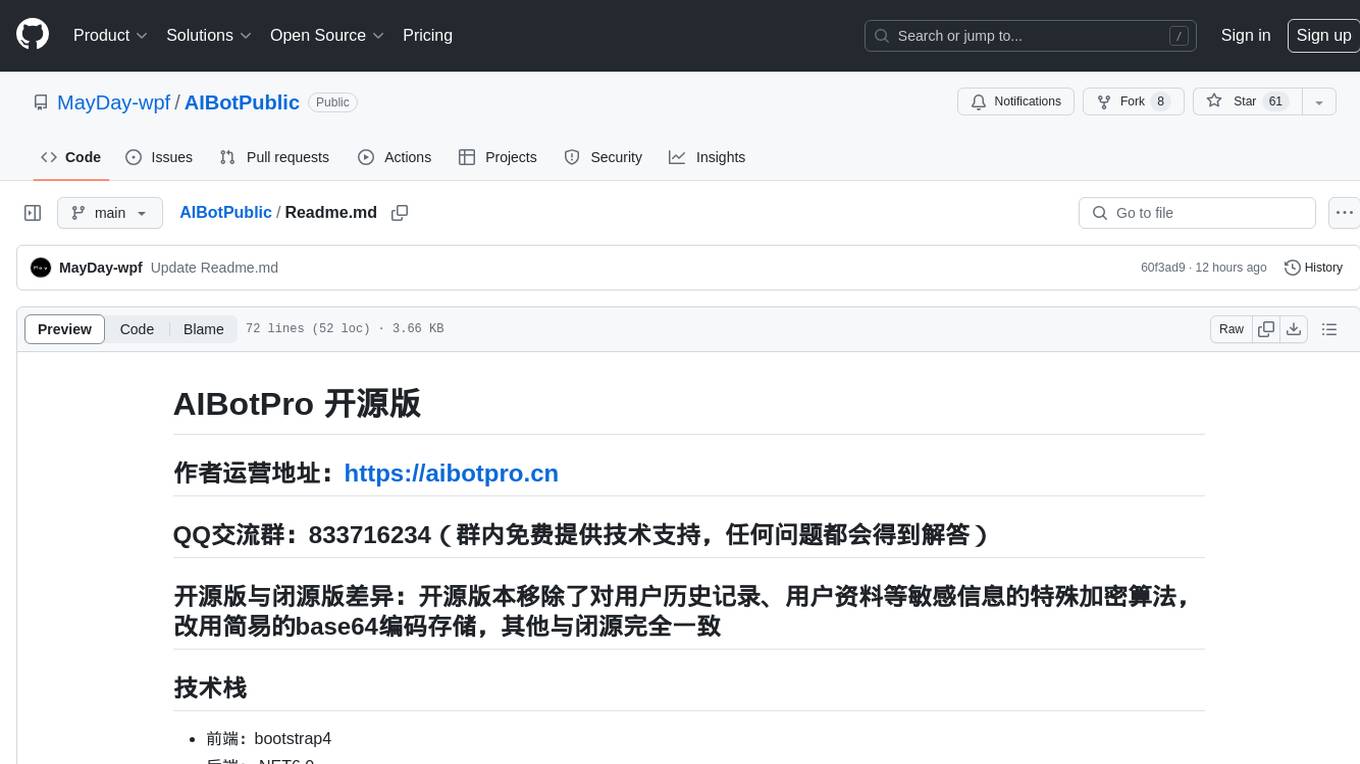
AIBotPublic
AIBotPublic is an open-source version of AIBotPro, a comprehensive AI tool that provides various features such as knowledge base construction, AI drawing, API hosting, and more. It supports custom plugins and parallel processing of multiple files. The tool is built using bootstrap4 for the frontend, .NET6.0 for the backend, and utilizes technologies like SqlServer, Redis, and Milvus for database and vector database functionalities. It integrates third-party dependencies like Baidu AI OCR, Milvus C# SDK, Google Search, and more to enhance its capabilities.

LLMGA
LLMGA (Multimodal Large Language Model-based Generation Assistant) is a tool that leverages Large Language Models (LLMs) to assist users in image generation and editing. It provides detailed language generation prompts for precise control over Stable Diffusion (SD), resulting in more intricate and precise content in generated images. The tool curates a dataset for prompt refinement, similar image generation, inpainting & outpainting, and visual question answering. It offers a two-stage training scheme to optimize SD alignment and a reference-based restoration network to alleviate texture, brightness, and contrast disparities in image editing. LLMGA shows promising generative capabilities and enables wider applications in an interactive manner.
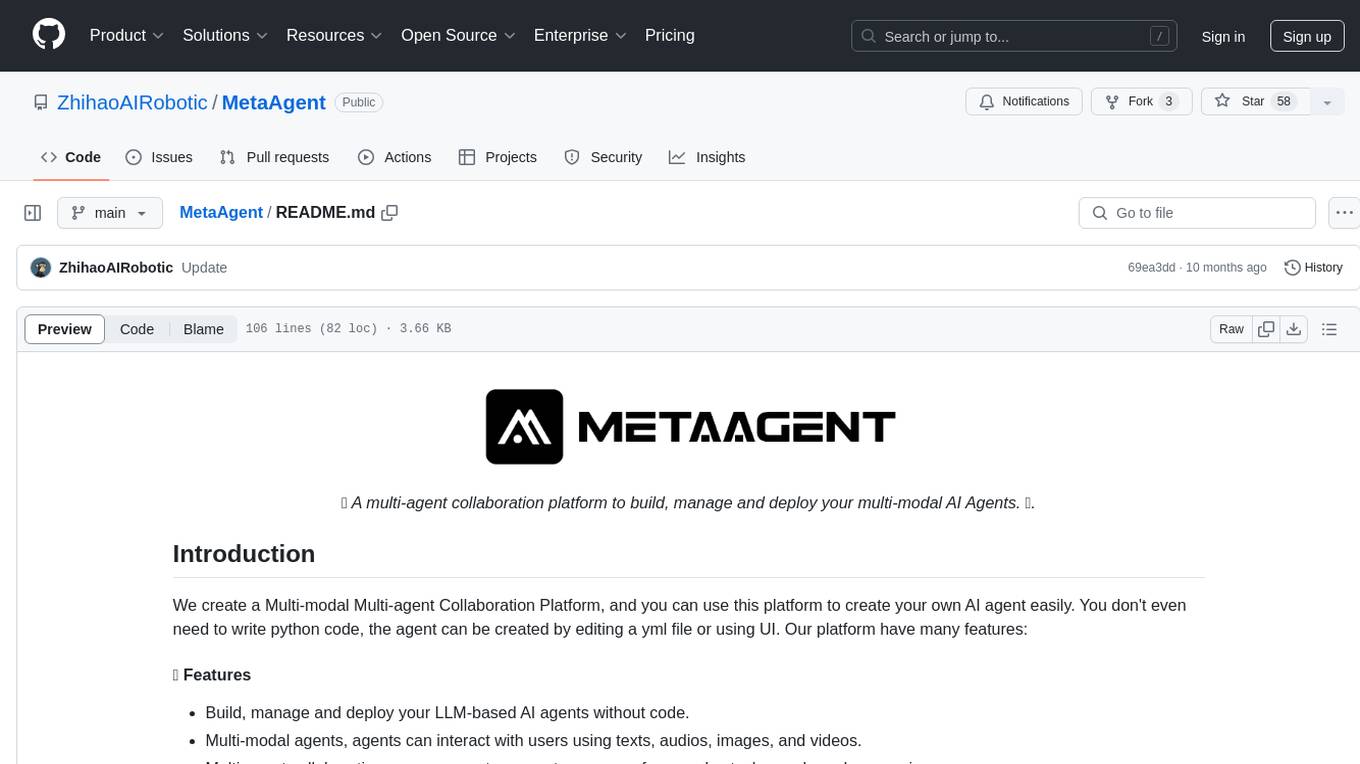
MetaAgent
MetaAgent is a multi-agent collaboration platform designed to build, manage, and deploy multi-modal AI agents without the need for coding. Users can easily create AI agents by editing a yml file or using the provided UI. The platform supports features such as building LLM-based AI agents, multi-modal interactions with users using texts, audios, images, and videos, creating a company of agents for complex tasks like drawing comics, vector database and knowledge embeddings, and upcoming features like UI for creating and using AI agents, fine-tuning, and RLHF. The tool simplifies the process of creating and deploying AI agents for various tasks.


